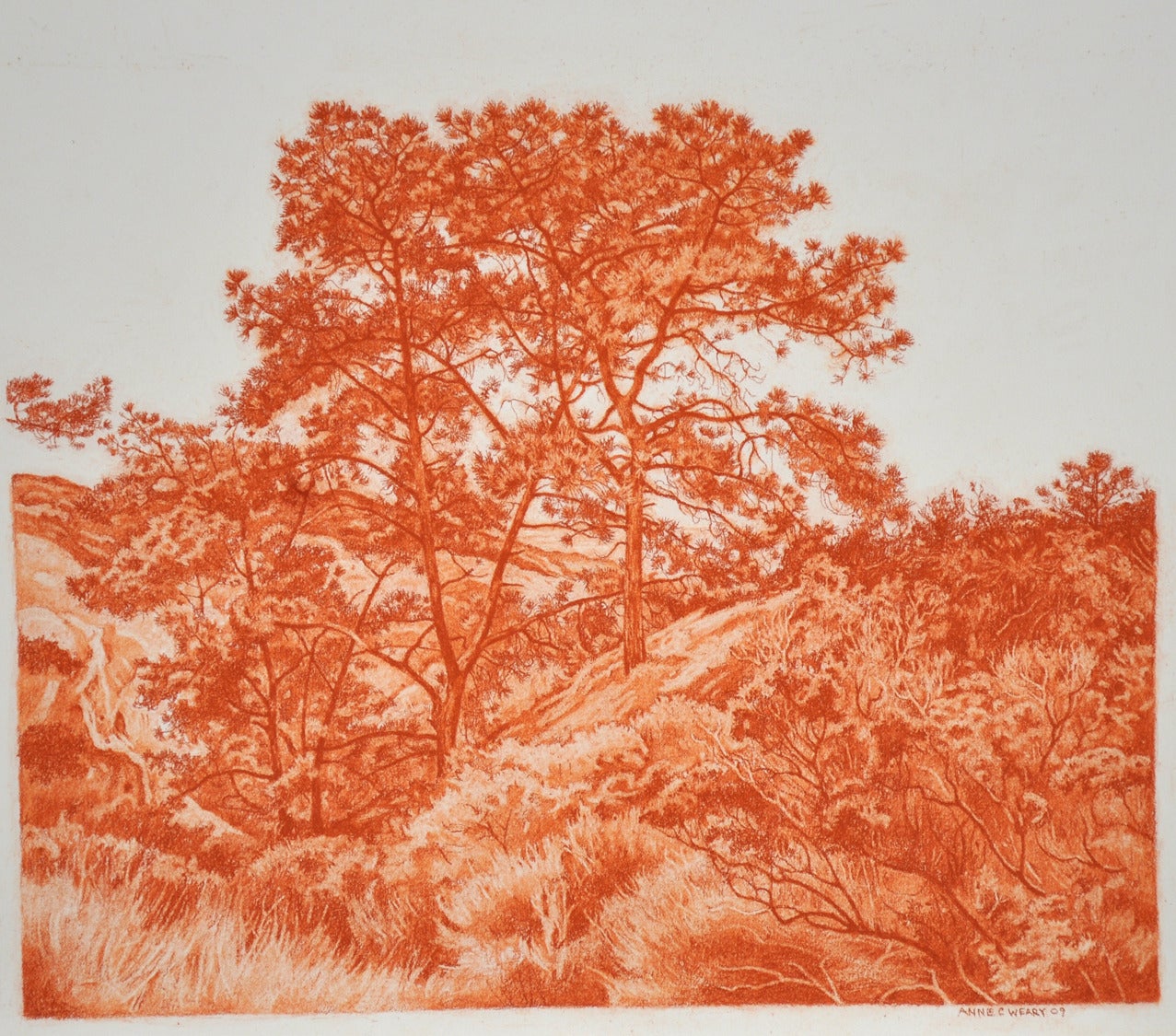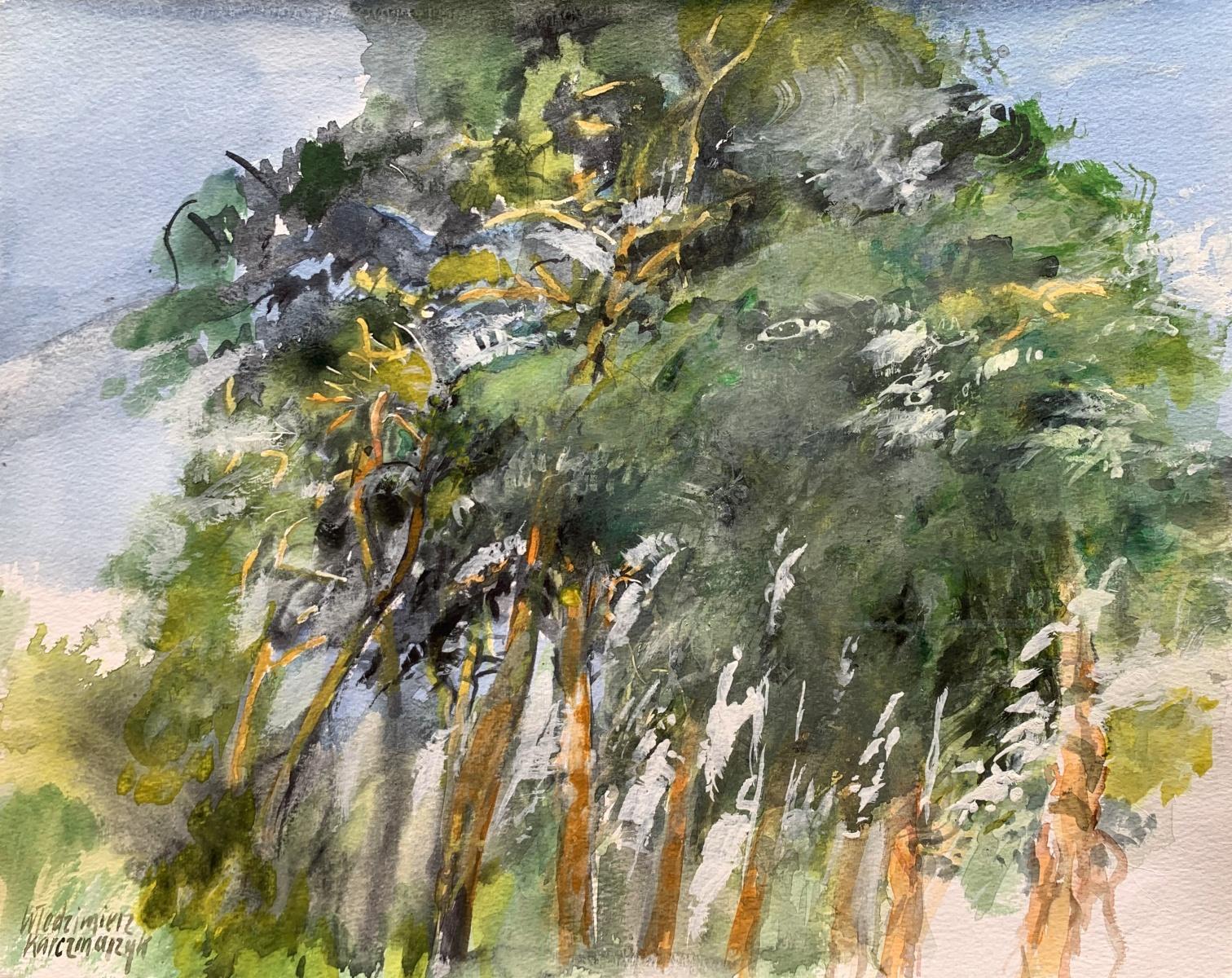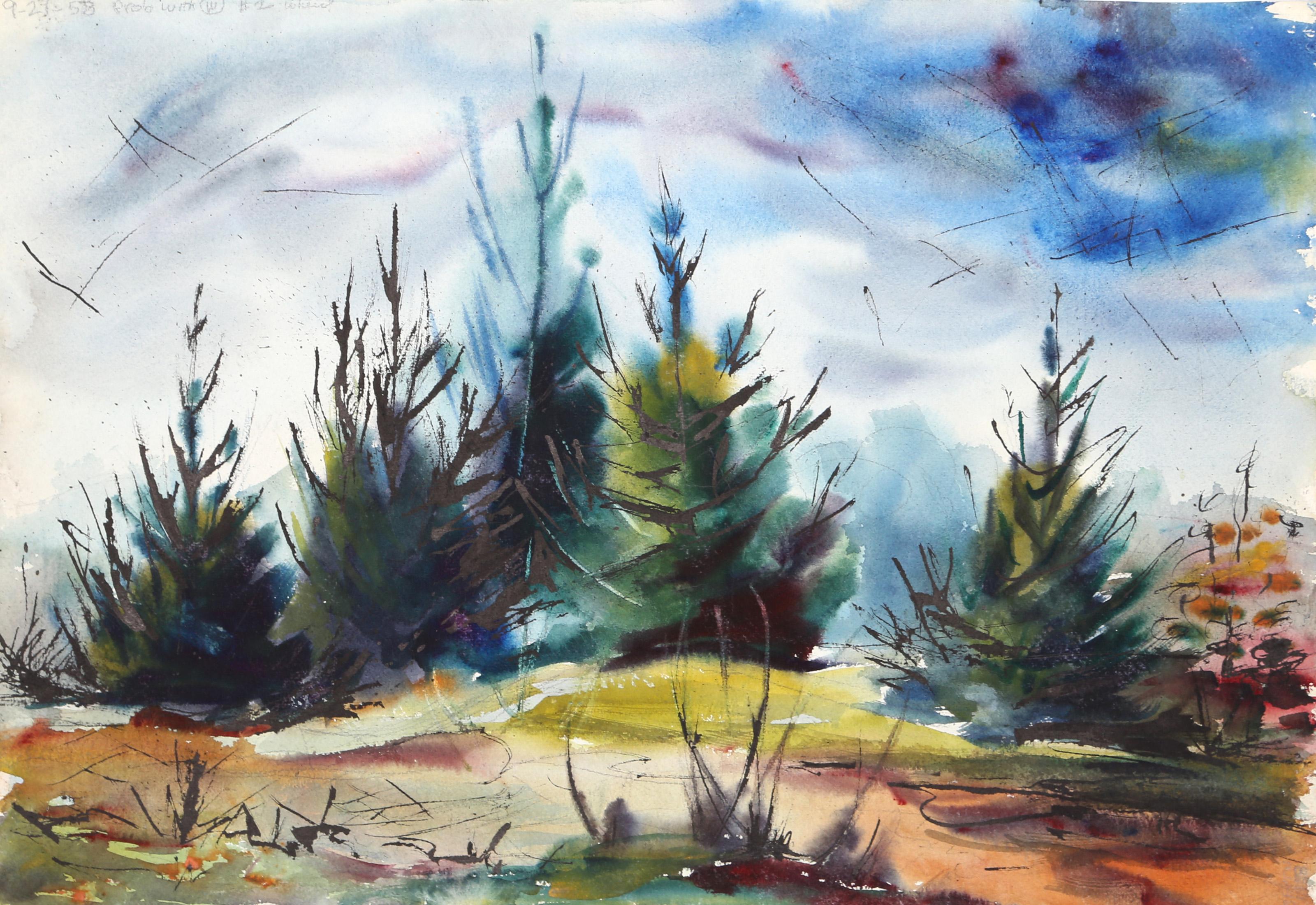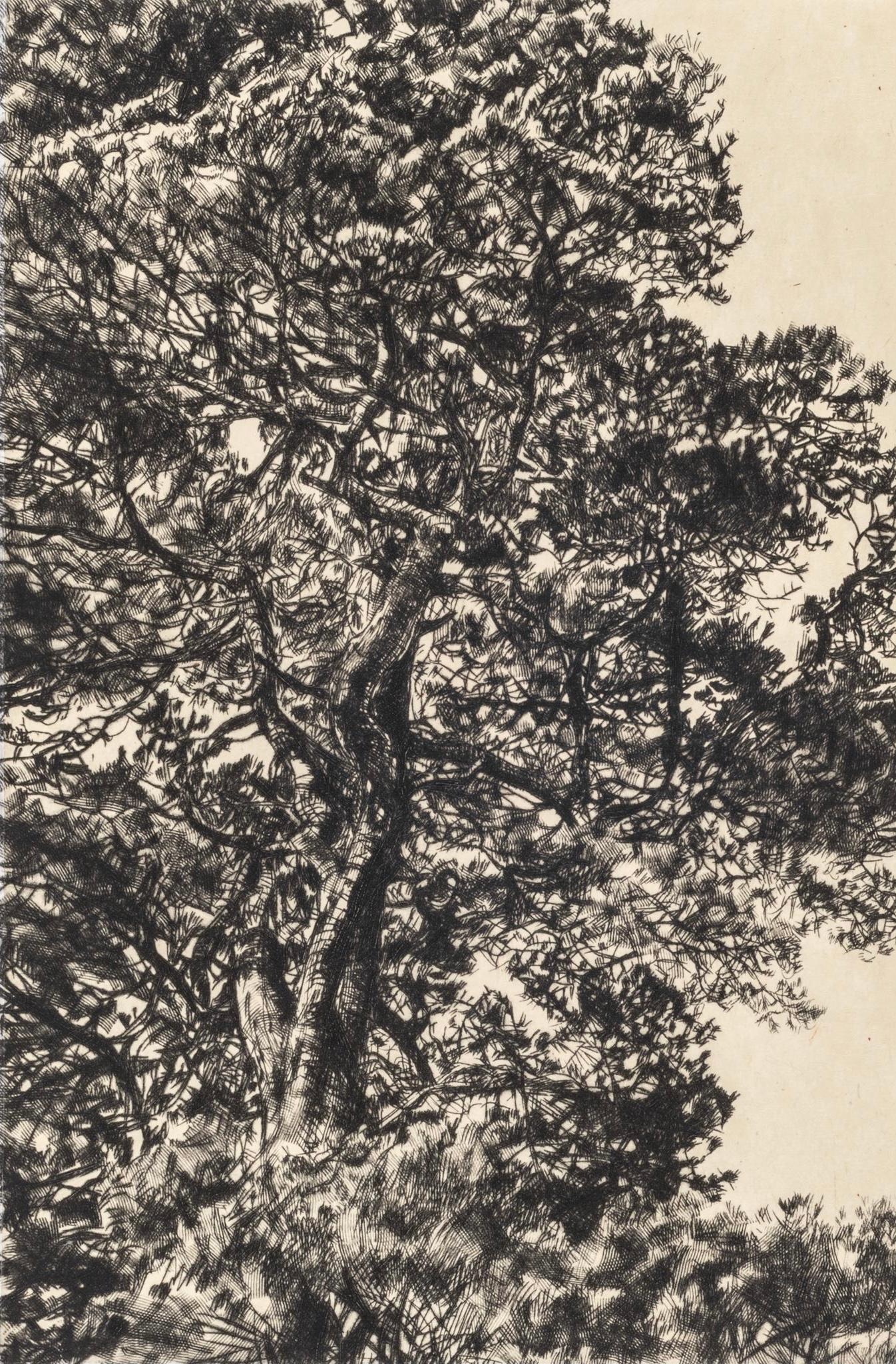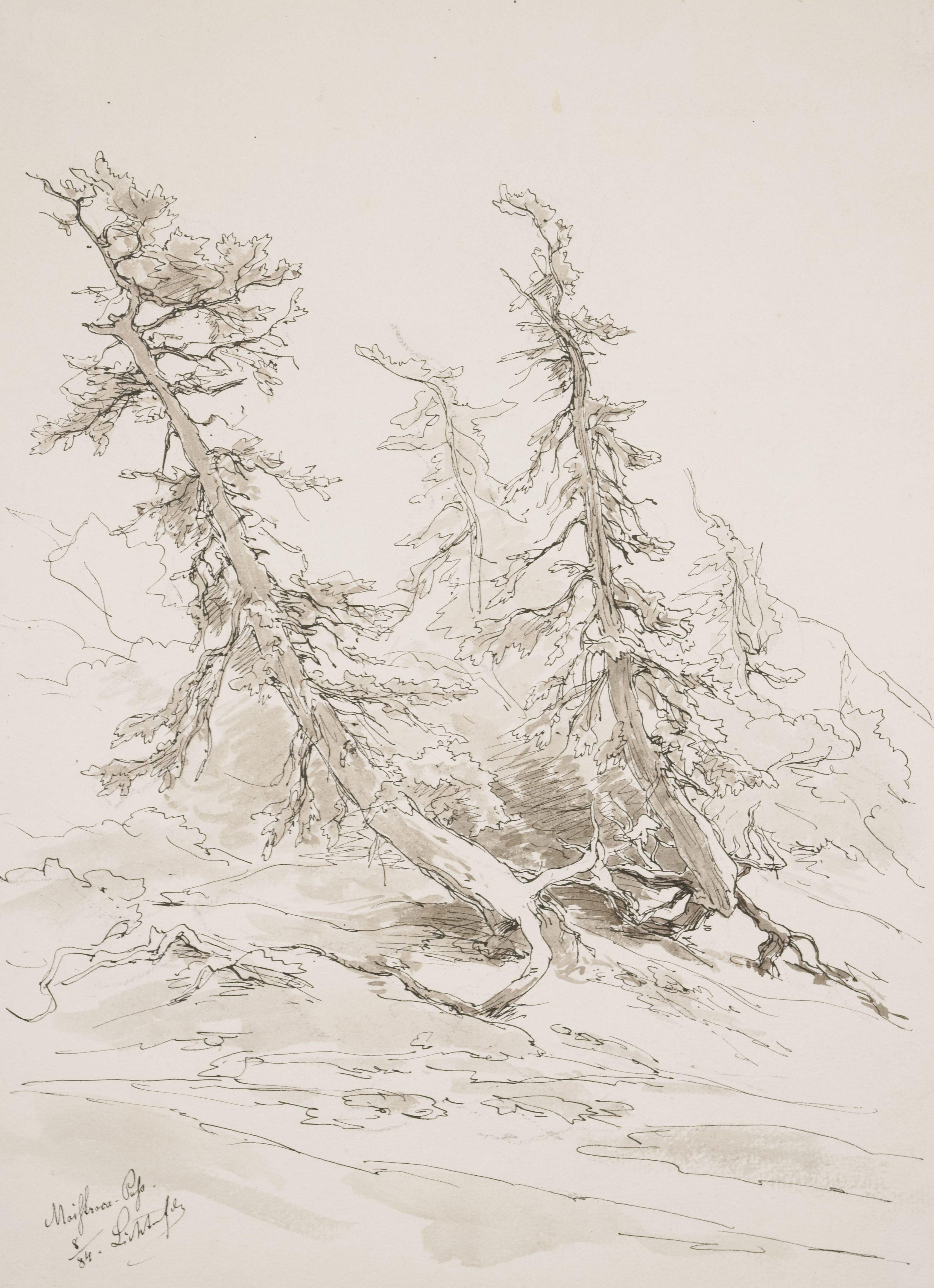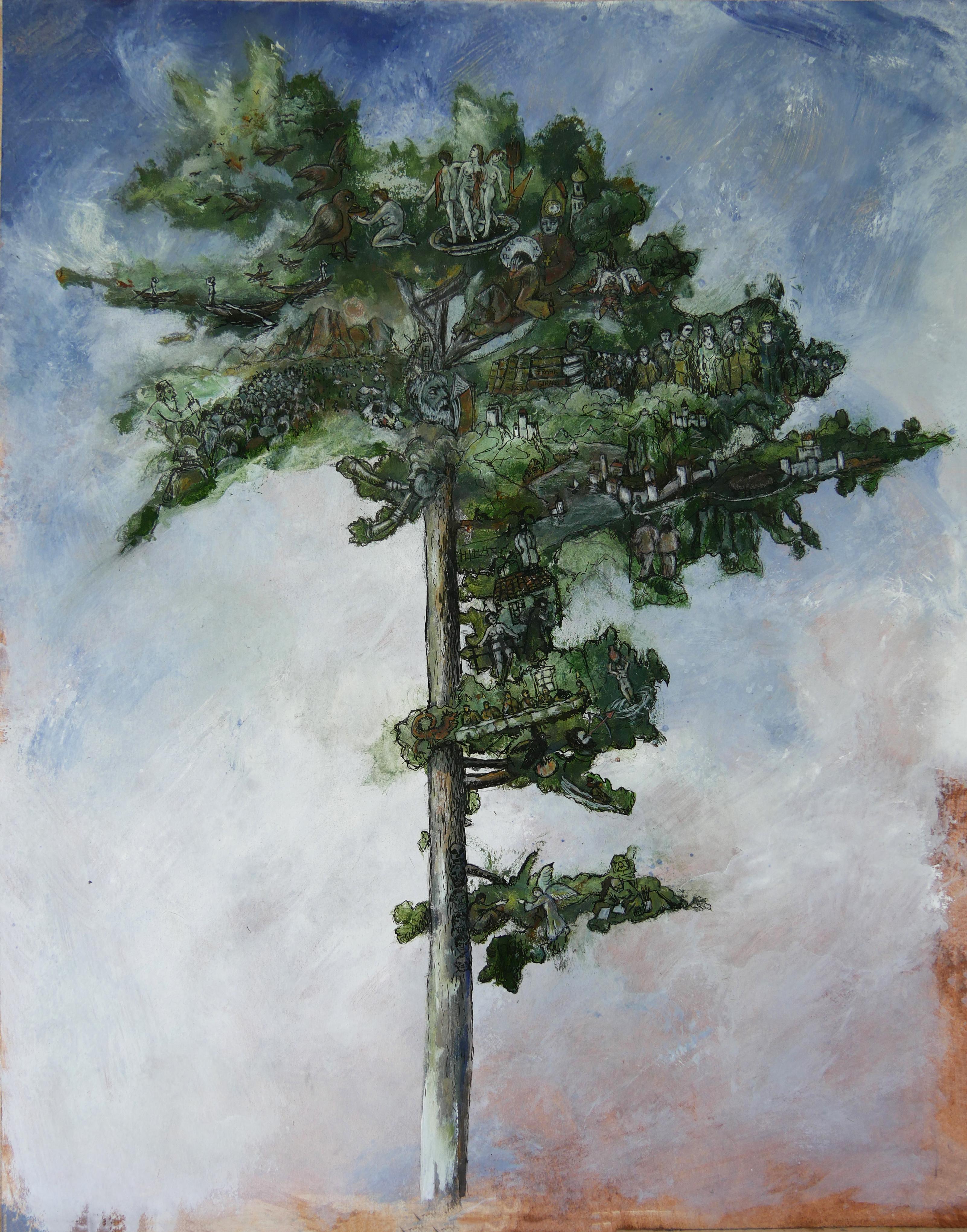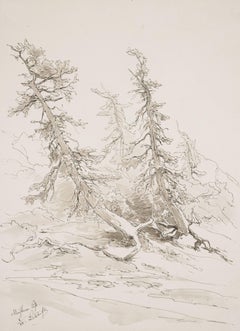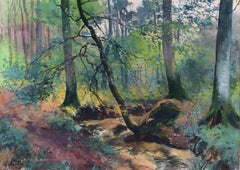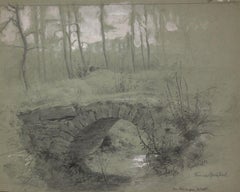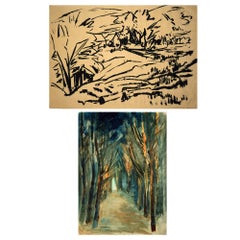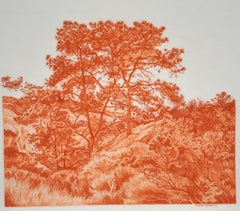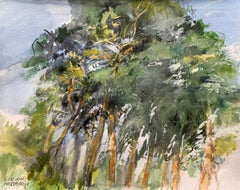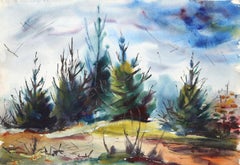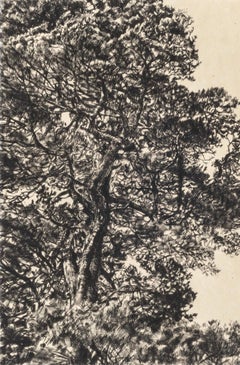Items Similar to Norwegian Pine Grove - The inner glow of the trees -
Want more images or videos?
Request additional images or videos from the seller
1 of 6
Themistokles von EckenbrecherNorwegian Pine Grove - The inner glow of the trees -1901
1901
$1,145.19
$1,431.4920% Off
£846.66
£1,058.3220% Off
€960
€1,20020% Off
CA$1,575.20
CA$1,96920% Off
A$1,750.93
A$2,188.6620% Off
CHF 917.80
CHF 1,147.2520% Off
MX$21,383.10
MX$26,728.8820% Off
NOK 11,458.21
NOK 14,322.7620% Off
SEK 10,780.04
SEK 13,475.0520% Off
DKK 7,308.46
DKK 9,135.5820% Off
About the Item
Themistokles von Eckenbrecher (1842 Athens - 1921 Goslar), Norwegian pine grove, 1901. Watercolor on blue-green paper, 30 x 22 cm. Signed, dated and inscribed in his own hand "TvE. Fagermes [i.e. Fagermes]. 26.6.[19]01."
- Slight crease throughout at left margin, otherwise in good condition.
About the artwork
Themistokles von Eckenbrecher often traveled to Norway to study the nature that fascinated him there. On June 26, 1901, near the southern Norwegian town of Fagernes, in the summer evening sun, he saw a small pine grove, which he immediately captured in a watercolor. He exposed the trees growing on a small hill in front of the background, so that the pines completely define the picture and combine to form a tense motif. The tension comes from the contrast of form and color. The trunks, growing upward, form a vertical structure that is horizontally penetrated by the spreading branches and the pine needles, which are rendered as a plane. This structural tension is further intensified by the color contrast between the brown-reddish iridescent trunks and branches and the green-toned needlework.
Themistokles von Eckenbrecher, however, does not use the observed natural scene as an inspiring model for a dance of color and form that detaches itself from the motif and thus treads the path of abstracting modernism. Its inner vitality is to be brought to light and made aesthetically accessible through the work of art.
It is precisely in order to depict the inner vitality of nature that von Eckenbrecher chooses the technique of watercolor, in which the individual details, such as the needles, are not meticulously worked out, but rather a flowing movement is created that unites the contrasts. The trees seem to have formed the twisted trunks out of their own inner strength as they grew, creatingthose tense lineations that the artist has put into the picture. The inner strength continues in the branches and twigs, culminating in the upward growth of the needles. At the same time, the trunks, illuminated by the setting sun, seem to glow from within, adding an almost dramatic dimension to the growing movement.
Through the artwork, nature itself is revealed as art. In order to make nature visible as art in the work, von Eckenbrecher exposes the group of trees so that they are bounded from the outside by an all-encompassing contour line and merge into an areal unity that enters into a figure-ground relationship with the blue-greenish watercolor paper. The figure-ground relationship emphasizes the ornamental quality of the natural work of art, which further enforces the artwork character of the group of trees.
With the presentation of Themistokles von Eckenbrecher's artistic idea and its realization, it has become clear that the present watercolor is not a study of nature in the sense of a visual note by the artist, which might then be integrated into a larger work context, but a completely independent work of art. This is why von Eckenbrecher signed the watercolor. In addition, it is marked with a place and a date, which confirms that this work of nature presented itself to him in exactly this way at this place at this time. At the same time, the date and place make it clear that the natural work of art has been transferred into the sphere of art and thus removed from the time of the place of nature.
About the artist
Themistocles' parents instilled a life of travel in their son, who is said to have spoken eleven languages. His father, who was interested in ancient and oriental culture, was a doctor and had married Francesca Magdalena Danelon, an Italian, daughter of the British consul in Trieste. During a stay in Athens - Gustav von Eckenbrecher was a friend of Heinrich von Schliemann and is said to have given him crucial clues as to the location of Troy - Themistokles saw the light of day in 1842.
After an interlude in Berlin, where Themistokles was educated at the English-American School, the journey began again. From 1850 to 1857 the family lived in Constantinople, after which the father opened a practice in Potsdam, where Themistokles, who wanted to become a painter, was taught by the court painter Carl Gustav Wegener.
In 1861 the von Eckenbrechers left Potsdam and settled in Düsseldorf. There Themistokles received two years of private tuition from Oswald Aschenbach, who greatly admired the talented young artist. After his artistic training, he undertook extensive travels, often accompanied by Prince Peter zu Sayn-Wittgenstein, which took him to northern and eastern Europe, but above all to the Middle East and even to South America. The paintings that resulted from these journeys established his artistic reputation and led to his participation in large panoramas such as the 118 x 15 metre Entry of the Mecca Caravan into Cairo, painted for the City of Hamburg in 1882.
1882 was also the start of a total of 21 study trips to Scandinavia, most of them to Norway, and the unique Norwegian landscape with its rugged fjords became a central motif in his work. Along with Anders Askevold and Adelsteen Normann, Themistokles von Eckenbrecher became one of the most sought-after artists in this field of landscape painting.
Although Düsseldorf had been his home until then, von Eckenbrecher moved to Potsdam in 1887 and to Berlin in 1889, where he taught for a time at Conrad Fehr's art academy. In 1919 he moved to Goslar, where he founded the local art association, after having been a member of the Düsseldorf Malkasten from 1861-1887 and of the Verein Berliner Künstler from 1889-1921.
On the occasion of Themistokles von Eckenbrecher's 100th birthday in 1942, the city of Goslar organised a commemorative exhibition showing 130 of his works.
Selected Bibliography
Siegfried Gehrecke: Themistokles von Eckenbrecher (= Goslarer Künstler und Kunsthandwerker 4), Goslar 1985.
Thank you for your interest! I hope I have been able to explain to you the special character of the artwork. If you have any questions of any kind, please feel free to contact me.
I wish you many more discoveries in the realm of art,
Dr Martin Kirves
GERMAN VERSION
Themistokles von Eckenbrecher (1842 Athen - 1921 Goslar), Norwegischer Kiefernhain, 1901. Aquarell auf blaugrünem Papier, 30 x 22 cm. Eigenhändig signiert, datiert und ortbezeichnet „TvE. Fagermes [d.i. Fagermes]. 26.6.[19]01.“
- leichte durchgehende Knickspur am linken Rand, sonst in gutem Erhaltungszustand
zum Kunstwerk
Themistokles von Eckenbrecher reiste immer wieder nach Norwegen, um dort die ihn faszinierende Natur zu studieren. So hielt er sich auch im Jahre 1901 in Norwegen auf und erblickte am 26. Juni nahe dem südnorwegischen Städtchen Fagernes in der sommerlichen Abendsonne einen kleinen Kiefernhain, den er umgehend als Aquarell festhielt. Dabei stellte er die auf einer kleinen Kuppe wachsenden Bäume vor dem Hintergrund frei, so dass die Kiefern das Bild ganz bestimmen und sich zu einem spannungsvollen Motiv zusammenschließen. Die Spannung resultiert aus einem Form- und Farbkontrast. Die in die Höhe wachsenden Stämme verbinden sich zu einer vertikalen Struktur, die von den ausgreifenden Ästen und dem flächenartig dargestellten Nadelbesatz horizontal durchdrungen wird. Diese strukturelle Spannung wird durch den Farbkontrast der braunrötlich changierenden Stämme und Äste und dem grüntonalen Nadelwerk noch intensiviert.
Themistokles von Eckenbrecher verwendet die beobachtete Naturszenerie aber nicht als inspirierende Vorlage für ein sich von der Motivik ablösenden Farb- und Formreigen und beschreitet damit den Weg einer abstrahierenden Moderne, ihm geht es um die Natur selbst. Ihre innere Lebendigkeit soll zum Vorschein gebracht und durch das Kunstwerk ästhetisch zugänglich werden.
Gerade um die innere Lebendigkeit der Natur vor Augen stellen, wählt von Eckenbrecher die Technik des Aquarells, bei der die einzelnen Details, wie die Nadeln, nicht akribisch ausgearbeitet werden, sondern eine die Kontraste miteinander verbindende fließende Bewegung entsteht. Die Bäume scheinen die gewundenen Stämme aus ihrer eigenen inneren Kraft so geformt zu haben, wie sie gewachsen sind und damit jene spannungsvollen Lineaturen erzeugt, die der Künstler ins Bild gesetzt hat. Die innere Kraft setzt sich in die Äste und Zweige hinein fort und kulminiert in dem nach oben ausschwingenden Nadelbewuchs. Dabei wirken die von der Abendsonne beschienenen Stämme als ob sie von innen aufglühen würden, was der gewachsenen Bewegung eine beinahe dramatische Dimension verleiht.
Durch das Kunstwerk gibt sich die Natur selbst als Kunst zu erkennen. Um die Natur als Kunst im Kunstwerk sichtbar werden zu lassen, stellt von Eckenbrecher die Baumgruppe frei, so dass sie sich durch eine umfassende Konturlinie nach außen hin abgrenzt und zu einer flächenmäßigen Einheit zusammenschließt, die mit dem blaugrünlichen Aquarellpapier ein Figur-Grund-Verhältnis eingeht. Das Figur-Grund-Verhältnis stellt die ornamentale Qualität des natürlichen Kunstwerks heraus, was den Kunstwerkcharakter der Baumgruppe zusätzlich forciert.
Mit der Darlegung von Themistokles von Eckenbrechers künstlerischer Idee und ihrer Realisation ist deutlich geworden, dass es sich bei dem vorliegenden Aquarell nicht um eine Naturstudien im Sinne einer visuellen Notiz des Künstlers handelt, die dann möglicherweise in einen größeren Werkzusammenhang eingeht, sondern um ein ganz eigenständiges Kunstwerk. Daher hat von Eckenbrecher das Aquarell signiert. Zudem ist es ortsbezeichnet und mit einem tagesgenauen Datum versehen, was bestätigt, dass sich ihm dieses Kunstwerk der Natur an diesem Ort zu dieser Zeit auf eben diese Weise dargeboten hat. Zugleich verdeutlicht die Datierung und auch die Ortbezeichnung, dass das Kunstwerk der Natur in die Sphäre der Kunst überführt damit der Zeit des Naturortes enthoben worden ist.
zum Künstler
Themistokles‘ Eltern legten ihrem Sohn, der elf Sprachen beherrscht haben soll, das Reiseleben in die Wiege. Der an antiker und orientalischer Kultur interessierte Vater war Arzt und hatte die Italienerin und Tochter des britischen Konsuls von Triest, Francesca Magdalena Danelon, geehelicht. Während eines Aufenthalts in Athen – Gustav von Eckenbrecher war mit Heinrich von Schliemann befreundet und soll ihm entscheidende Hinweise zum Auffinden von Troja gegeben haben – erblickte 1842 Themistokles das Licht der Welt.
Nach einem Intermezzo in Berlin, wo Themistokles auf der englisch-amerikanischen Schule unterrichtet wurde, ging es wieder auf Reisen. Von 1850-1857 wohnte die Familie in Konstantinopel. Anschließend eröffnete der Vater eine Praxis in Potsdam, wo Themistokles, mit dem Wunsch Maler zu werden, vom dortigen Hofmaler Carl Gustav Wegener unterrichtet wurde.
1861 verließen die von Eckenbrechers Potsdam und wurden in Düsseldorf ansässig. Dort erhielt Themistokles zwei Jahre Privatunterricht von einem der führenden Landschaftsmaler, Oswald Aschenbachs, der den talentierten jungen Künstler außerordentlich schätzte. Im Anschluss an die künstlerische Ausbildung unternahm von Eckenbrecher, oftmals in Begleitung des Fürsten Peter zu Sayn-Wittgenstein, ausgedehnte Reisen, die ihn nach Nord- und Osteuropa, vor allem aber in den Vorderen Orient und sogar bis nach Südamerika führten. Die aus den Eindrücken dieser Reisen hervorgegangenen Gemälde begründeten seinen künstlerischen Ruhm und führte zu Beteiligungen an großen Panoramen wie den 1882 für die Stadt Hamburg gemalten 118 x 15 Meter messenden Einzug der Mekkakarawane in Kairo.
1882 war auch das Auftaktjahr für die insgesamt 21 Studienreisen nach Skandinavien, von denen ihn die meisten nach Norwegen führten, so dass die einzigartige norwegische Landschaft mit ihren schroffen Fjorden zu einem zentralen Motiv seines Oeuvres wurde. Neben Anders Askevold und Adelsteen Normann avancierte Themistokles von Eckenbrecher zu einem der gefragtesten Künstler dieser Richtung der Landschaftsmalerei.
War Düsseldorf bisher sein Heimathafen gewesen, zog von Eckenbrecher 1887 nach Potsdam und siedelte 1889 nach Berlin über, wo er zeitweise an der Kunstakademie von Conrad Fehr unterrichtete. 1919 ging er schließlich nach Goslar und gründetet den dortigen Kunstverein, nachdem er von 1861-1887 Mitglied im Düsseldorfer Malkasten gewesen war und sich von 1889-1921 im Verein Berliner Künstler bestätigt hatte.
Zu Themistokles von Eckenbrechers 100. Geburtstag veranstaltete die Stadt Goslar 1942 eine Gedächtnisausstellung, auf der 130 seiner Werke zu sehen waren.
Auswahlbibliographie
Siegfried Gehrecke: Themistokles von Eckenbrecher (= Goslarer Künstler und Kunsthandwerker 4), Goslar 1985.
Vielen Dank für Ihr Interesse! Ich hoffe, ich habe Ihnen den besonderen Charakter des Kunstwerks näherbringen können. Bei Fragen jeglicher Art können Sie mich gerne kontaktieren.
Ich wünsche Ihnen noch viele Entdeckungen im Reich der Kunst,
Dr. Martin Kirves
- Creator:Themistokles von Eckenbrecher (1842 - 1921, German)
- Creation Year:1901
- Dimensions:Height: 11.82 in (30 cm)Width: 8.67 in (22 cm)
- Medium:
- Movement & Style:
- Period:
- Condition:
- Gallery Location:Berlin, DE
- Reference Number:1stDibs: LU2438212304362
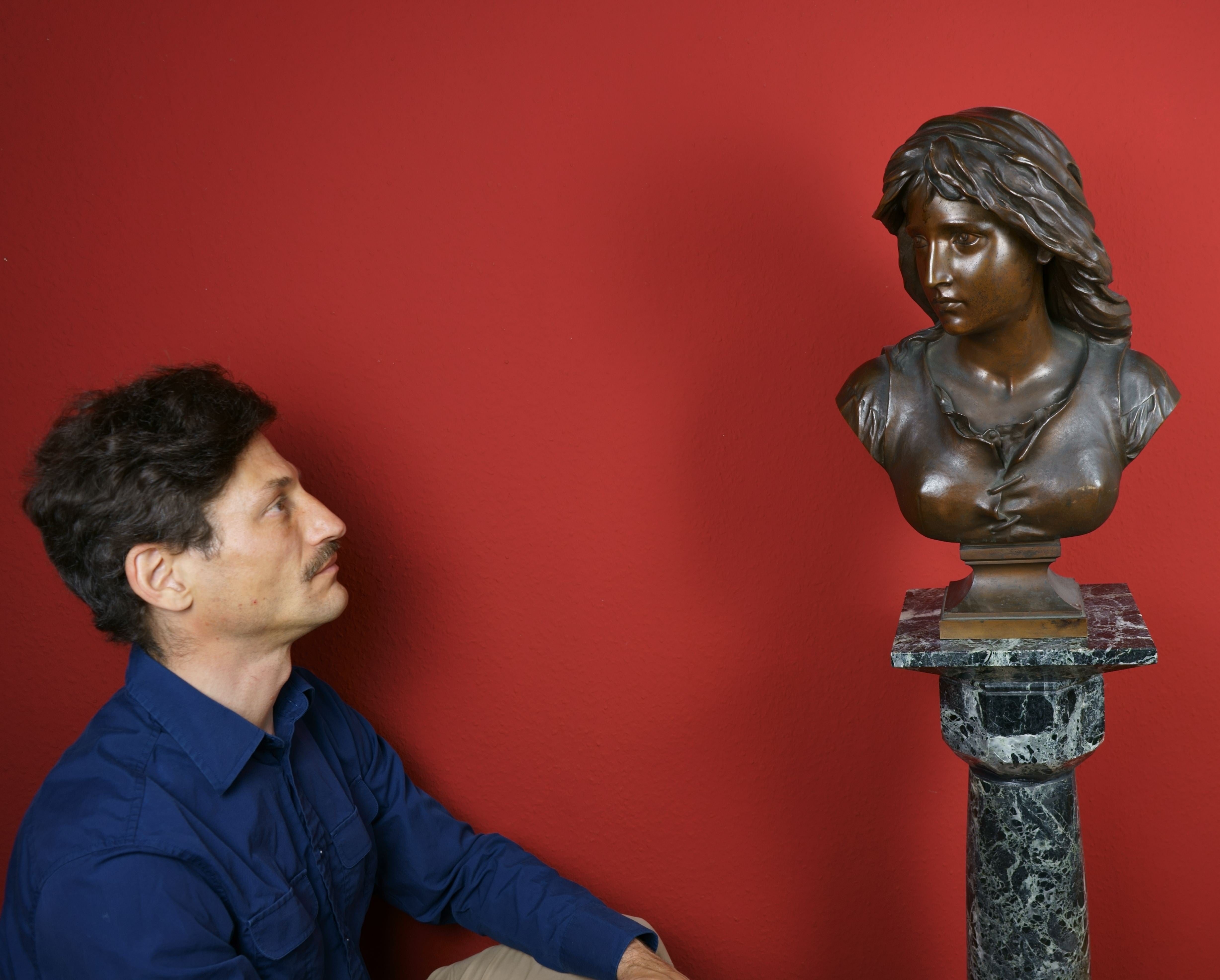
About the Seller
5.0
Vetted Professional Seller
Every seller passes strict standards for authenticity and reliability
Established in 2014
1stDibs seller since 2023
21 sales on 1stDibs
- ShippingRetrieving quote...Shipping from: Berlin, Germany
- Return Policy
Authenticity Guarantee
In the unlikely event there’s an issue with an item’s authenticity, contact us within 1 year for a full refund. DetailsMoney-Back Guarantee
If your item is not as described, is damaged in transit, or does not arrive, contact us within 7 days for a full refund. Details24-Hour Cancellation
You have a 24-hour grace period in which to reconsider your purchase, with no questions asked.Vetted Professional Sellers
Our world-class sellers must adhere to strict standards for service and quality, maintaining the integrity of our listings.Price-Match Guarantee
If you find that a seller listed the same item for a lower price elsewhere, we’ll match it.Trusted Global Delivery
Our best-in-class carrier network provides specialized shipping options worldwide, including custom delivery.More From This Seller
View AllWoodland / - The Inner Drama of the Landscape -
Located in Berlin, DE
Eduard Peithner von Lichtenfels (1833 Vienna - 1913 Berlin), Woodland, 1884. Watercolor and pen and ink on drawing paper, 30.4 cm x 22.5 cm, signed, dated and inscribed by the artist...
Category
1880s Landscape Drawings and Watercolors
Materials
Paper
Summer Forest Landscape, 1915 / - The Forest Walk -
Located in Berlin, DE
Stanislas Warnie (1879-1958), Summer Forest Landscape, 1915. Watercolor, 31.5 cm x 45 cm (passepartout), 50.5 cm x 63.5 cm (frame), signed "S. Warnie" at lower left and dated "1915"....
Category
1910s Art Nouveau Landscape Drawings and Watercolors
Materials
Watercolor
$620 Sale Price
20% Off
In the forest of Durlach - Quiet ripple in a secret place -
Located in Berlin, DE
Franz Xaver Graessel (1861 Oberasbach/Baden - 1948 Emmering). In the forest of Durlach. 1881. Pencil drawing, heightened with white, on grey-green paper. 33 x 41.7 cm. Signed, dated and inscribed by the artist himself: 'Franz Graessel. Durlach, 12 April 1881".
About the artwork
The drawing depicts a view of the woods which, as if sharpening the visual focus, remains diffuse at the edges and does not allow the viewer to locate himself in the picture. As a result, the landscape appears to be an apparition, but at the same time it is given real substance by the solidity of the massive arched bridge made of quarry stone. As the main motif of the painting, the bridge, which blends in with nature like an archaic relic, also acts as a visual guide, drawing attention to the white, raised waters of the stream and the surrounding vegetation. The diffusion of perception that takes place there, however, draws the eye back to the bridge and thus to the overall view. This movement initiating a constant alternation of diffusion and concretion, which is the specific tension of the painting that brings the landscape to life. The materialisation and dematerialisation, however, does not take place solely through the eye's wandering through the picture; it is simultaneously linked to the viewer's approach to and distance from the picture, which loses its richness of detail precisely in the close-up, only to reconfigure itself with increasing distance.
In this work, which dates from Graessel's studies in Karlsruhe, the artist reflects on the emergence of pictorial objectivity. Here, however, nature is more than a mere motif. The real connection between culture and nature is symbolically expressed by the choice of green paper.
The drawing is an impressive testimony to Graessel's mastery of the sprezzatura with which he skilfully applies the most abstract of strokes, which visibly merge towards the centre of the picture. The signature and the exact date prove that Graessel gave this work more than the character of a mere sketch.
About the artist
Franz Graessel grew up in an environment that was to nourish his later key motifs: his parents' house was a mill. After attending the Karlsruhe Academy of Art from 1878 to 1884, where he studied under Carl Hoff, Graessel continued his training at the Munich Academy from 1886 to 1890 as a pupil of Wilhelm von Lindenschmidt. Trained primarily in genre and portrait painting, he initially portrayed the life of Black Forest farmers. From 1894 he turned increasingly to animal painting, concentrating on the depiction of ducks and geese, which earned him the nickname 'Enten-Graessel'. Graessel's work thus parallels that of Alexander Koester...
Category
1880s Naturalistic Landscape Drawings and Watercolors
Materials
Chalk, Pencil, Paper
$2,290 Sale Price
20% Off
Landscape verso Forest interior / - Landscape as a space of imagination -
Located in Berlin, DE
Herbert Seidel (1906 Berlin - 1974 Rüdersdorf), Landscape verso Forest interior, around 1950. India ink on grained, bleached paper, 40.5 x 58 cm, signed “Herbert Seidel” in pencil on...
Category
1950s Abstract Landscape Drawings and Watercolors
Materials
Paper
Shady hollow way - Into the heart of the forest -
By Hans Dvoràk
Located in Berlin, DE
Hans Dvořák (19th century). Shady hollow way in a sunny forest. Watercolour and pen-and-ink drawing, 58.5 x 43 cm (visible size), 70 x 55.5 cm (frame), signed and dated "Hans Dvořák ...
Category
1880s Realist Landscape Drawings and Watercolors
Materials
Watercolor
$1,336 Sale Price
20% Off
Forest landscape bathed in sunlight / - The Monumentality of the Forest -
Located in Berlin, DE
Wilhelm Feldmann (1859 Lüneburg - 1932 Lübeck), Sunny forest landscape, c. 1900. Oil on canvas, marouflaged on wood, 37 cm x 48 cm (inside dimensions), 42.5 cm x 53.5 cm (frame), sig...
Category
Early 1900s Impressionist Landscape Paintings
Materials
Oil
You May Also Like
Pines in Ravine
By Anne C. Weary
Located in Dallas, TX
“Anne Weary, who grew up as a Texas cowgirl, is at home in the outdoors and knows its ways and its language. There is a sort of very quiet but very powerful mysticism in her work, a sense of presence that goes quite beyond words,” wrote poet and University of Texas at Dallas professor Frederick Turner in the American Arts Quarterly.
Dallas born Weary studied under Olin Travis, Octavio Medellin and Chapman Kelley before earning a 4 year certificate from the Pennsylvania Academy of Fine Arts with awards for excellence in drawing. In 2008, Weary left Texas for a three year sabbatical in Southern California where she began drawing in Torrey Pines State Natural Reserve with red conté...
Category
21st Century and Contemporary Contemporary Landscape Drawings and Waterc...
Materials
Conté, Paper
Above all- pines. Watercolor, tempera on paper, Landscape, Classic, Polish art
By Włodzimierz Karczmarzyk
Located in Warsaw, PL
Contemporary watercolor and tempera painting on paper by Polish artist Wlodzimierz Karczmarzyk. The title is 'Above all- pines'. Main colour is green. Artwork's style is sketch-like ...
Category
Early 2000s Other Art Style Landscape Drawings and Watercolors
Materials
Paper, Watercolor, Tempera
Pines, Impressionist Watercolor by Eve Nethercott
By Eve Nethercott
Located in Long Island City, NY
Eve Nethercott, American (1925 - 2015) - Pines (P5.33), Year: 1958, Medium: Watercolor on Paper, Size: 15 x 21.5 in. (38.1 x 54.61 cm), Description: Scattered over the rollin...
Category
1950s Impressionist Landscape Drawings and Watercolors
Materials
Watercolor
Autumn Pine, Limited edition print, Landscape, Tree, Nature art
By Fiona Hamilton
Located in Deddington, GB
This print of a pine tree uses kitakata Japanese tissue chine collé to depict the warmth and colour of early autumnal light. It is then backed onto Hahnemule printmaking paper. The subject matter is from Ashton Court Estate in Bristol. This body of work is based on the book by Suzanne Simard, 'Finding the Mother Tree'. Trees communicate via mycorrhizal fungi to trade water and other nutrients. Ancient and mature trees nurture their offspring via these networks, as well as trading nutrients between other species. Botanist Simard has spent years working on this theory as part of a wider body of work, discovering what it means for forests, the climate and the wider Anthropocene. My work explores the ecological sublime and an appreciation of the majesty of nature. I use detailed intaglio etching, drypoint, lithography and chine collé to draw the viewer into an ethereal landscape that has an impact on our sense of place in relation to the natural world. I use primarily black and white with natural tones of chine collé and sometimes layers of lithographic texture to introduce warmth to the stark palette and to invoke a sublime emotional connection. I work from sketches, photographs, notes and memory to create my prints.
ADDITIONAL INFORMATION:
Black & White, Chine Collé, Drypoint, Drypoint print, Etching, Etching print on Paper
Edition of 20
44 H x 32 W x 1 D cm (17.32 x 12.60 x 0.39 in)
Sold unframed
Image size:
Height: 30cm (11.81 in)
Width: 20cm (7.87 in)
Complete size of sheet
Height: 44cm (17.32 in)
Width: 32cm (12.60 in)
Depth: 1cm (0.39 in)
ARTIST BIOGRAPHY:
Fiona Hamilton is a printmaker based in Bristol. Interested in process she uses a combination of mediums, both traditional and contemporary, to produce unique imagery, often as one off pieces or in small limited editions. She currently works in silkscreen, cyanotype and foil.
Fiona’s artwork draws on a lot of natural themes such as plants, leaves, trees and creatures including lots of birds. She mostly works directly from nature or from photographs she has taken. She regularly lugs a heavy telephoto lens about to get photos of birds...
Category
2010s Contemporary Landscape Prints
Materials
Drypoint, Etching
"Great Pine", Tree Inhabited by Human in Nature, Drawing and Pigments on Paper
By Frank Girard
Located in Clermont-Ferrand, Auvergne-Rhône-Alpes
This drawing by Frank Girard is created with pigments, Chinese ink, watercolors, acrylic, and colored pencils on 300g/m2 neutral white paper. It is not framed.
Through drawings, the...
Category
2010s Realist Figurative Drawings and Watercolors
Materials
Paper, Ink, Acrylic, Watercolor, Color Pencil, Pigment
"Great Pine", Tree Inhabited by Human in Nature, Drawing and Pigments on Paper
By Frank Girard
Located in Clermont-Ferrand, Auvergne-Rhône-Alpes
This drawing by Frank Girard is created with pigments, Chinese ink, watercolors, acrylic, and colored pencils on 300g/m2 neutral white paper. It is not fr...
Category
2010s Realist Figurative Drawings and Watercolors
Materials
Paper, Ink, Watercolor, Pigment, Acrylic, Color Pencil
More Ways To Browse
Norway Paintings
Norwegian Painters
Large Horizontal Landscape Paintings
Antique Hat Tree
Line Drawings Male
Dior Fur Hat
Wegner At15
Fur Hat Used
Constantinople Painting
Italian Needlework
German Trunks Antique
Hamburg America Line
Elf Antique
Constantinople Landscape Painting
Peter Lassen
Worden Day
Antique German Elf
Adelsteen Normann
